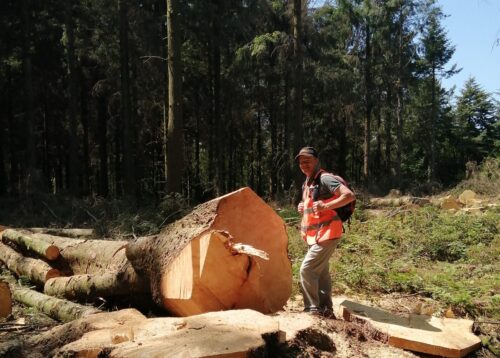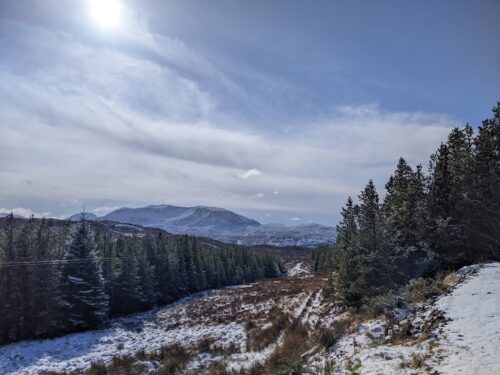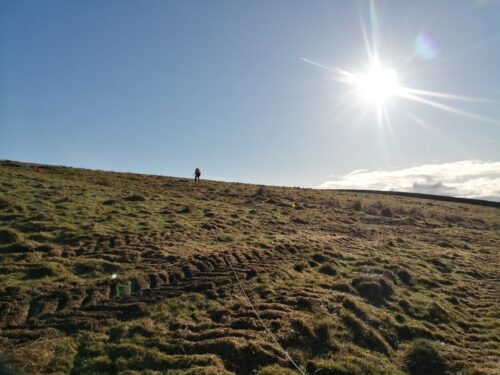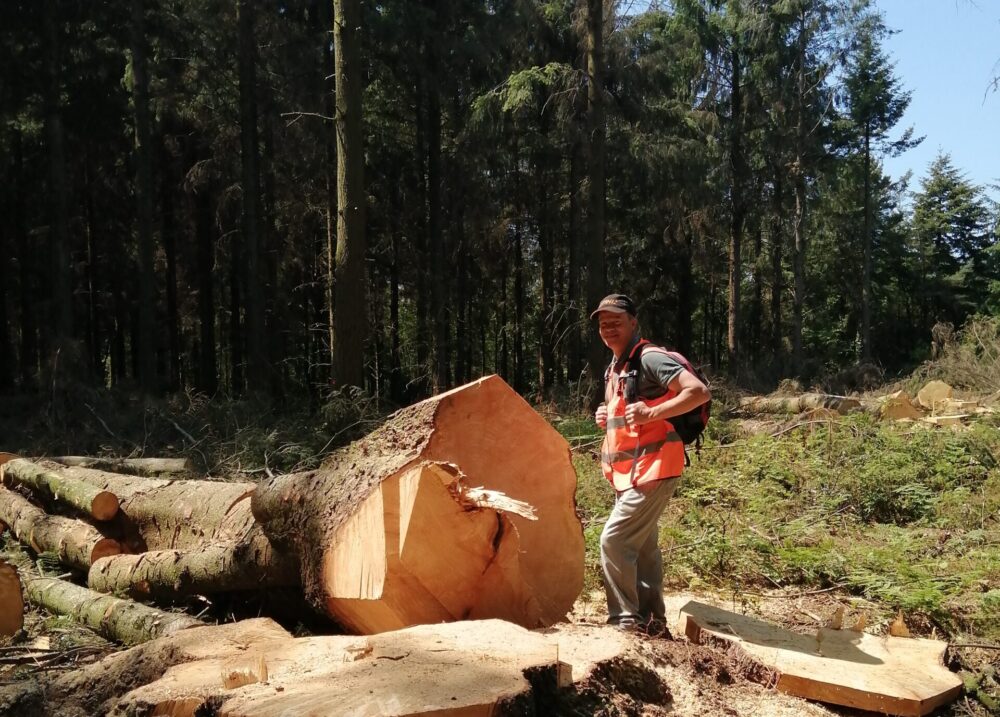Tilhill shadowing experience between the 4th and 9th of June 2023.
After initially contacting and speaking to Jenny Bjars, an experienced forest manager in the Cullompton, Devon office, I was pointed in the direction of the HR department. A small amount of form filling was required for Health and Safety and Insurance purposes.
I was to be a shadow for a week, watching but not working, exploring the career spectrum of foresting (growing/managing woodlands) and harvesting (cutting them down and preparing for replanting).
Safety Induction
My first day started with a safety induction, supply of a high visibility vest, a hard hat and importantly Tick spray (more on this later!). Tilhill and their contractors do take safety very seriously with daily written hazard assessments by contractors, and weekly monitoring by Tilhill foresters to protect clients. Forestry can obviously be dangerous with large machines, chainsaws, public access to woodlands, unpredictable weather, and sadly Ash dieback (and other species) requiring management decisions to keep the public safe from falling diseased and dead wood.

Site Visits
Being the hottest, sunniest week of the year, it was a relief to be within the canopy of the trees. The forest managers, Alex and Jenny, kept me in the trees and out of the office most of the week in locations as varied as the Quantocks, Blackdown Hills and East Devon coastal woodlands. The small amount of office time was used to follow up on information collected on woodland / tree assessments, access maps and take part in an area meeting of the close knit team, to share developments, opportunities through EWCO (English Woodland Creation Offer), and consider fire risks and mitigation in the present dry conditions.
Client aims and the types of woodlands under management proved very diverse. Management varied accordingly. Some woodlands were commercial coniferous. Other woodlands managed to be publicly accessible and cost neutral combined conifer and deciduous, requiring harvested trees to fund the works needed to keep rights of access safe, and a steady stream of managed crops for harvesting in the decades ahead. A particularly interesting privately owned large woodland was managed with the help of stewardship schemes to replant, control rhododendron and bracken, and even encompassed deforestation to develop heathland. A challenging idea for woodland managers who naturally expect to be replanting or afforesting.
Much of a forester’s work, as in any business, requires producing the product that a buyer wants. Mensuration measures the height and DBH of the trees, predicting the saleable timber and yield class to be harvested from a plot. A range of species were measured including Sitka, Norwegian Spruce, Douglas fir and Larch. Felling licenses could then be organized for the areas identified as optimal for harvesting. Sounds simple, however, the forest manager also needed to consider how the removal of one plot, for instance Sitka, would leave a considerably more valuable Douglas Fir plot potentially exposed to wind blow.
I particularly enjoyed assessing young trees, what and why particular species had been planted, and how pest challenges are controlled. This interest is probably linked to my previous agricultural and horticultural background. It still took a good few rows to get my eye in. No weevil damage but deer damage is a very real problem.
Contractors were very positive and friendly, demonstrating the good respectful working relationships with Jenny and Alex to cover all paper and physical requirements of a successful operation.
Thanks to the entire Cullompton team for being so welcoming, but especially to Jenny and Alex, answering all questions, introducing me to all contractors, and going beyond any initial query to give me a comprehensive picture. My advice to anyone considering taking a look at commercial forestry is to do it. Sharpen up on your tree identification before you go. The challenge then is to learn identification from the bark and cross ends. I found that my idea of commercial forestry was not altered but the theoretical bones fleshed out in the reality of successful crops and harvesting and the many challenges and pitfalls to be stepped around by professional foresters along the way.
On a slightly different note, an exciting lifetime first for me was hearing a Goshawk call (not so much for any grey squirrels in range!). A second first was ticks……use the spray……I was warned !!
A blog by Assistant Harvesting Manager, Kinsey Aikman
The rolling hills and stunning vistas of the Highlands of Scotland are renowned the world over for their beauty and grandeur. But there is more to these mountains than just their natural splendour.
The Highlands are home to a thriving timber industry, one that plays a crucial role in the sustainable management of Scotland’s forests and in the fight against climate change.

A blog by Assistant Forest Manager Harry Cooling
My experience so far working in forestry in Northern England can be characterised by two words ‘variety’ and ‘responsibility’!




